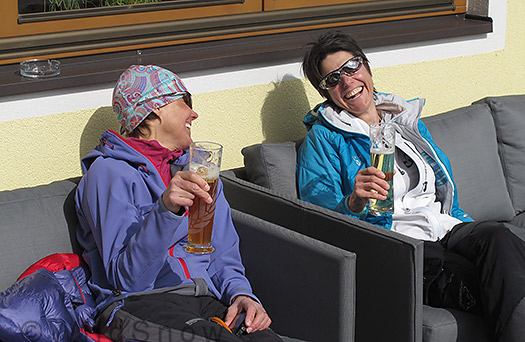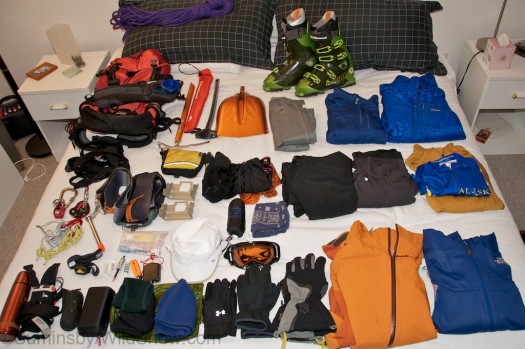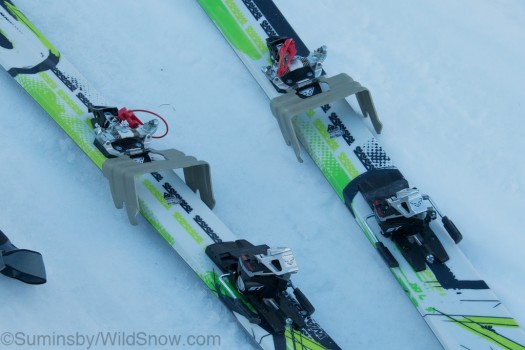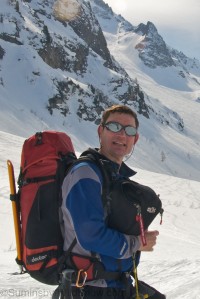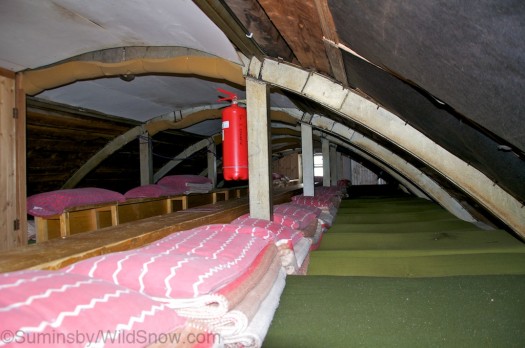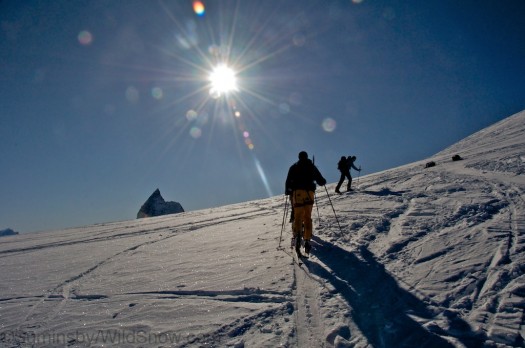Robert Suminsby
So you’ve finally booked the airline tickets for your first multi-day hut tour in the Alps. Visions of icy spires and vast glacial valleys buried deep in fresh snow keep you awake at night as you begin to plan for your odyssey through the world’s most storied mountains.
As you draft your gear list, you don’t want to leave behind something you might really need, right? Just to be thorough, you check the airline website to see what an extra checked bag will set you back, and discover that the price has gone up from $50 to “First-born child.” Ouch.
So maybe you CAN leave a few of your favorite pieces of gear at home. But what, exactly, will you need? Here are a few suggestions for those contemplating a week-long hut tour.
Leave-behind bag
Not everything that leaves the states with you needs to stay with you the whole time. When you come back grubby and unshaven from a week in the high mountains you’ll certainly enjoy the luxury of some clean clothes to change into, so bring a bag you can leave behind at your hotel luggage room with a change of clothes, walking shoes and anything else you don’t want on your back when you’re bootpacking up a couloir. Check with your hotel in advance, but most will be happy to store a bag for you if you are staying with them on either end of a hut trip.
Out-on-the town clothes
If you are making this trip with a significant other, at some point one of you is going to ask the question, “Are you bringing anything nice to wear?” If you are trying to travel light, fear not. Even in the glitzier resort towns in the Alps, there are very few places where you wouldn’t feel completely comfortable in a clean base layer top and a pair of trekking pants.
Skis/Boots
Do you really need to bring them? Most of us would say yes, but if you’re not in love with your current setup, renting skis in Europe is an option that could save you big in oversize baggage charges. Shops in the major European ski capitals, such as Chamonix, usually offer a decent selection of touring gear, so do some research before you decide. You may be pleasantly surprised at the options you find. (And if you can’t determine what’s available from a shop’s website, call them. Almost every shop will have someone who speaks English.) No one wants to take chances with unfamiliar boots on a multi-day trip, so bringing your own is a must. As the Dawsons and many others do, if your boots are custom fitted and hard to replace, haul them as carry-on baggage. Lou likes to just strap his together and dangle around his neck, but a boot bag can be nice. In either case, plan ahead for carry-on volume and restrictions.
Hardware
For most major tours in Europe, you will spend a good part of your time on glaciers, so a climbing harness, several carabiners, prusik loops, and a couple of slings are essential. However, if you’re using a guide service, they may provide this kit. Some will also equip you with an ice axe and crampons, or permit you to rent them for the week. If you decide to buy an ice axe, just because it will look so cool hanging up in the garage, select a small one, 55 or 60 cm. (In case it isn’t obvious, Agent Trotsky of the TSA will take a very dim view of trying to pack this in your carry-on.) You’ll also want ski crampons for negotiating icy skin tracks, and obviously a beacon, shovel and probe. If you are traveling with a guide, he or she will have a complete crevasse rescue kit and a rope. If not, someone in your party will need this and know how to use it.
PackFor a multi-day tour, a 35L pack should do nicely, and if you don’t stuff it full you can make this your carry-on bag for the flight. Pack all your planned gear into it (including the layers you won’t be wearing on a sunny day), load it up with about 2 liters of water, and weigh it. Hopefully it’ll weigh in under 25 pounds, or else you’ll need to attend Lou’s remedial “Ounces Count” seminar, where you’ll be forced to do 100-rep arm curls with a 1980s-era Lange boot on each hand.
Glasses and Goggles
If you are fortunate enough to have good weather, it’s going to be very bright in those high mountains well above treeline. Most of the time you’ll want a good pair of glacier glasses, but goggles are an insurance policy if you get caught in high winds and blowing snow.
Hats and GlovesYou’ll want two hats, a knit cap for warmth, and a light and breathable sun cap for sunny days. I recommend abandoning your fashion sense and wearing a Lawrence of Arabia-style sunhat, complete with earflaps and a long back to cover your neck. (You can take it off for hero shots.) Warm gloves are a must, but if the weather is fine, you’ll want something light and breathable that protects you from sunburn and allows you dexterity for putting on skins, adjusting buckles, and so forth. Ideally, look for gloves with a removable liner so that you can wear the liner, the shell, or both as conditions dictate.
Layers
Like any tour, what you need to stay warm and dry is a personal choice, but a few tips are in order. A good hard shell is essential, but you probably won’t be wearing it much, so err on the light side. A lightweight soft-shell mid-layer will see much more use. For an extra warming layer, a down or synthetic puffy will pack smaller than a fleece, and is very nice to throw on at the hut before the stove gets cranked up in the evening. For base layers, you should be able to get by with two; one to wear during the day, and another to change into after you arrive at the hut and to sleep in later. Yes, the one you wear every day will be pretty nasty, but no one’s going to notice after day two because they will smell the same. Wool blends are highly encouraged as they’ll be much less funky-smelling than synthetics. Soft shell touring pants are an obvious essential; augment them with lightweight rain pants that you can put on as an extra layer if the weather really turns bad.
Socks
Two pairs of ski socks should suffice, but consider treating yourself to the luxury of a heavy wool pair to weare around the hut. The huts provide clogs, but those won’t keep your toes warm. Again, wool wins out over synthetic vapors when you are sleeping 12 or 16 to a room!
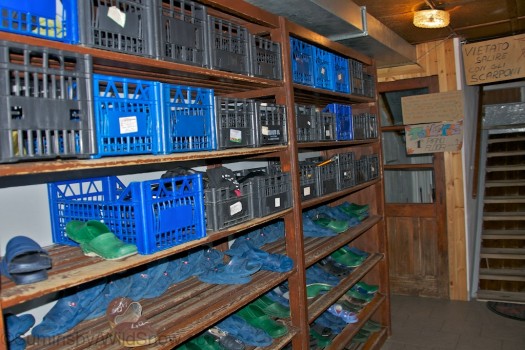
Crocs are unbiquitious in European huts. Storage bins are for things like crampons that don't belong in sleeping rooms.
Misc
Speaking of sleeping, all you’ll need to bring is a sleeping bag liner. A silk one will pack down very small, weighs only about 5 ounces, and should keep you warm under the duvet covers supplied by the hut. A headlamp is vital both for early morning starts, and middle-of-the-night visits to the bathroom. You’ll need a small toiletries kit, but everything you really need (small toothbrush, travel tube of toothpaste, comb) should fit in a ziploc sandwich bag. Don’t forget a personal first aid kit, with a few bandaids, moleskin and other blister treatments, sunscreen, chapstick, ibuprofen and aspirin. Your guide should be carrying a more comprehensive first aid kit–if not, you will want a few more items for emergencies. In another ziploc bag, tuck your passport, one credit card, and cash for the days you’ll be in the huts. Things like water and snacks (to say nothing of wine and beer) can be pricey when you’re paying to have them delivered by helicopter so don’t get caught short.
Depending on where your trip takes you, the local currency may be either Euro (€) or Swiss Franc (CHF). Even the Swiss huts take Euro, although at a slightly less favorable exchange rate. The Swiss use coins for denominations as large as 5 CHF, and while I’ll defer to the finely calibrated scales at WildSnow HQ on the exact weight of a 5 CHF coin, it’s definitely heavier than a €5 note.
Must-haves
Don’t forget a camera. The whole point of this trip is to earn the undying envy of your ski buddies, so you want to bring back great pictures. This is one area where I personally throw weight considerations out the window: I have schlepped a full-size Nikon DSLR all over the Alps, and never regretted it. YMMV, however, and you may be just as happy with a point-and-shoot, or some of the new cameras that fall somewhere in between. If you shoot a lot of photos, consider a spare battery.
Finally, the single most indispensible item of all: earplugs. With a room full of tired skiers who have dulled the pain in their aching legs with several beers or a bottle of Valpolicella, it’s a stone cold certainty that someone in your room is going to snore!
(WildSnow.com guest blogger Rob Suminsby is a recently retired U.S. Air Force officer who has been skiing for many decades. When Rob had to give up flying F-15s, he turned to off-piste skiing, and eventually ski touring, to get his thrills. For the past four years he has lived in Germany, and traveled over much of the Alps in search of untracked snow. He recently moved to New Mexico with his wife, two sons, and a Basset Hound named Buddy. His search for the goods will continue.)
Beyond our regular guest bloggers who have their own profiles, some of our one-timers end up being categorized under this generic profile. Once they do a few posts, we build a category. In any case, we sure appreciate ALL the WildSnow guest bloggers!

